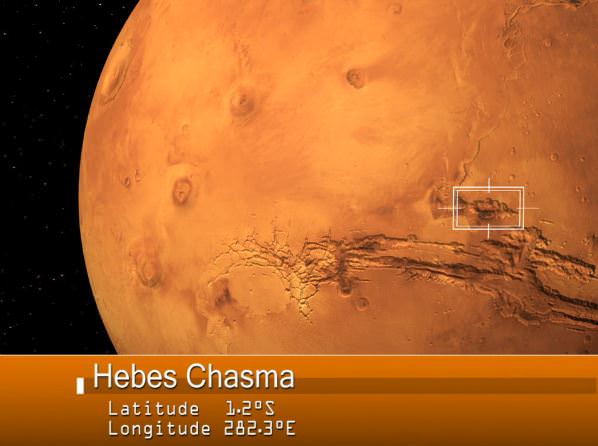Take a ride through a Hebes Chasma, a canyon just north of the largest canyon on Mars – and the Solar System — Valles Marineris. The video provides an awesome view, but this is not a wild ride with Luke Skywalker through trenches of the Death Star …. it’s more like a tourist pleasure cruise which provides picturesque views of this 8 km-deep canyon.
ESA provides all the tourist info of what you are seeing:
The movie glides over impact craters pockmarking the plains separating the troughs, down cliff faces scarred by landslides, and along the rough valley floor.
In some parts of the valley Mars Express has detected water-bearing minerals, suggesting that significant quantities of water may have once flowed here.
The formation of Hebes Chasma is likely connected to the nearby volcanic Tharsis region, home to the planet’s vast Olympus Mons volcano.
During periods of intense volcanism the whole region stretched upwards, causing tremendous stress in the crust further way. Unable to withstand the strain, the crust ripped open, collapsing into the chasms found in and around Valles Marineris.
Funny, I was just thinking over the weekend it had been a long time since I’d seen a flythough video from Mars! If you need more, the HiRISE folks have a nice collection of flythrough videos here.
Source: ESA


Thank you for sharing this.
Is it just me or the video is not working? I found the same video posted on an actual ESA site (http://www.esa.int/Our_Activities/Space_Science/Fly_through_a_canyon_on_Mars) and that’s also not working, so I’m assuming the problem is with the source.
It’s working for me but I followed your link first. It didn’t work so I went back one in the navigation link to http://www.esa.int/Our_Activities/Space_Science and then accepted ESA’s cookies, then it worked.
ESA has now posted the video to You Tube (which usually works better across all operating systems and browsers than Flash), and we’ve updated the article with that video.
I can’t be 100% sure, but I’d almost bet that this animation was produced with vertical exaggeration. I’ll never understand why they go to the trouble of adding all the other details for realism (e.g. overcast sky, atmospheric haze) to create the impression that “you are there,” but then stretch the vertical scale, showing the way it would most certainly NOT look if you were actually there. And, worse, no indication for the casual viewer that such a stretch has been done, leaving the lay viewer with a very distorted perception of the topography.
Still think that the giant impactor that hit Mars and dug out the humongous crater feature called Hellas Planitia on nearly the opposite side, created the Valles Marineris and Tharsis chain of volcanoes (Antipodal location). Guess we’ll just have to go there to find out for sure!